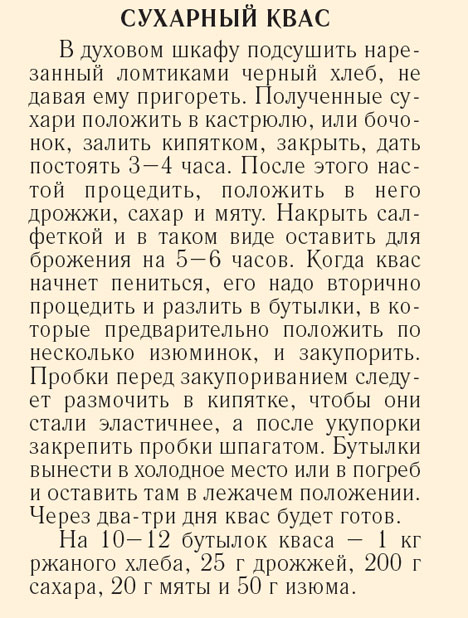.jpg)
'Crouton' kvas. Source: Anna Kharzeeva
This piece is part of the Soviet Diet Cookbook, a blog about a modern Russian girl cooking Soviet food. To read more of the series click here.
Kvas is a drink that is an absolute staple during the summer months in Russia. It’s been around for centuries and was the drink before beer came in — well, I wasn’t there, but that’s what I read. Typically for a very popular recipe, it can be made in dozens of ways — the main types of kvas are bread, fruit, berry and honey. The drink takes a few days to prepare and gives the perfect lazy summer entertainment for kids – it’s like watching a chemistry experiment.
I haven’t had kvas in about 15 years — ever since I got food poisoning drinking it from a huge barrel in the center of Moscow. Rumor has it those never get cleaned, and I believe it and don’t go anywhere near them when they start popping up like mushrooms after rain in the first warm days of the year.
But the time has come to combat my fears and try kvas again. Hopefully the kvas I make following the Book’s recipe won’t put me off it for another 15 years.
The recipe I found was for “crouton” kvas – it’s pretty much Russia’s love for dark bread in a bottle. The process is quite fun:
Day 1: I made croutons and poured boiling water over them. I did it before dinner, thinking I’d strain the liquid before going to bed. Went to bed, and woke up at 2am in a cold sweat – I forgot to strain the kvas! Strained it there and then, hoping the few extra hours wouldn’t make a difference. Added yeast, sugar and mint – proportions went all out of whack because the recipe is for 12 bottles! Not knowing if it was going to be drinkable at all, I cut it by 10, which wasn’t easy considering I can’t count to save my life – or my drink.
Day 2: Poured the kvass into bottles and put a raisin in each – I love that little touch! Put the bottles in a plastic bag and in the trunk of a car hoping a 2-hour drive into the mountains won’t hurt the kvas – surely all things Russian are meant to be tough?
Day 3: Found a Russian banya up in the mountains of Georgia. Now I can go all Russian and have kvas in the banya! Only thing is according to the recipe I should probably wait one more day. But how important is precision when the banya’s hot and you’re thirsty?
Well, as it turns out: very! My kvas turned out quite bready, but really dull and with bits of yeast floating about. Forget 12 bottles, taking one sip of it was enough.
Granny tells me I’m not the only one in the extended family who’s failed at kvas – although my fellow-kvass killers had an excuse: they were Israelis! Granny says they made kvas and when it didn’t turn out they rang her and asked where they failed – what a gift that wouldn’t have been for her! They followed the recipe to the letter, but – can you imagine? – asks granny, laughing, they used white bread instead of dark!
I don’t even have that excuse, although I will blame the book for not being more precise in details – it can’t just be me again, can it? It’ll have to be bottled kvas or no kvas at all from now on – and I know which one I’m leaning towards.

The recipe from the Soviet Cook Book, page 287
For 10-12 bottles of kvas: 1 kg rye bread; 25g yeast; 200g sugar; 20g mint; 50g raisins
Slice the bread and then put it in the oven until it is dry. Put the dry bread slices in a pot or barrel and pour boiling weater over them. Let sit 3-4 hours. Strain the bread mixture and add to the strained liquid the yeast, sugar and mint. Cover with a cloth and let sit and ferment 5-6 hours. When the mixture begins to foam, strain it again and put the liquid into bottles. Add a few raisins and put in caps or plugs. Before putting in the plugs, soak them in boiling water so they will become more elastic. After capping, tie the tops of the bottles with twine. Put in a cool dark place for 2-3 days.
All rights reserved by Rossiyskaya Gazeta.
Subscribe
to our newsletter!
Get the week's best stories straight to your inbox